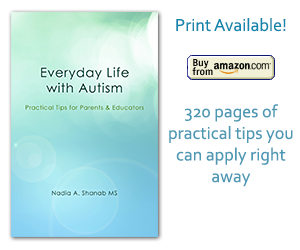By Nadia Shanab | autism, general advice, parenting, tips
You think you know your child well. Absolutely you know her/him well in certain settings. School is a highly structured setting compared to any other setting. School setting puts some pressure on the child because there are a minimum requirements of discipline expected from each student. Ask for an in-class observation as well as play
Tags: asperger's syndrome, autism, communication, discipline, flexibility, IEP, independence, mainstreaming, occupational therapy, one-on-one assistance, organization, parenting, placement, schedule, social interaction, speech, tips
Posted in autism, general advice, parenting, tips | Comments Off on Before You Go To An IEP Meeting
By Nadia Shanab | autism, general advice, parenting, tips
In a previous entry I explained the importance of a daily schedule. Now I will show you how to build your own magnetic schedule, which will look like this: Before I explain how to make a physical magnetic schedule (the most effective I’ve ever used), here are some rules that I would like to talk
Tags: asperger's syndrome, autism, communication, discipline, flexibility, independence, parenting, placement, rewards, schedule, senses, sensory, social interaction, techniques, tips
Posted in autism, general advice, parenting, tips | Comments Off on How To Create A Flexible Schedule
By Nadia Shanab | autism, general advice, parenting, tips
A new school year is around the corner and about to start! Parents and educators are you ready? Here are some tips to help you get off on the right foot. Bear in mind, there are three main goals in raising and educating children with autism that we are working on: Independence Improve Social Skills Improve Communication
Tags: asperger's syndrome, autism, communication, discipline, early intervention, flexibility, health, independence, organization, parenting, placement, rewards, schedule, senses, social interaction, tips, visual aids, visual timer
Posted in autism, general advice, parenting, tips | Comments Off on Parents & Educators, Get Ready For A New School Year Now
By Nadia Shanab | autism, general advice, parenting, tips
Anecdote I was shadowing a student with autism from a Special Day Class (SDC) in a mainstream class for Math subject. The student looked around scanning the faces of all the students surrounding her. With confused and lost eyes the student looked at me and asked: “Am I a special ed student?” She was loud enough
Tags: asperger's syndrome, autism, communication, early intervention, flexibility, independence, placement, schedule, social interaction, special education, tips
Posted in autism, general advice, parenting, tips | Comments Off on How To Respond To The Question: Am I A Special Ed Student?
By Nadia Shanab | autism, general advice, parenting, tips
To diagnose autism no lab work, devices, nor equipment are needed. The only thing that is requested from parents and licensed professionals to do is to fill out some questionnaires. Filling out papers is based on observing the child’s behavior in different settings, like interacting with family members, strangers, at home, new places, with toys
Tags: amazon, asperger's syndrome, autism, diagnosis, DSM-5, parenting, placement, research, senses, signs of autism, social interaction, speech, symptoms of autism
Posted in autism, general advice, parenting, tips | Comments Off on Guidelines To Diagnose Autism
By Nadia Shanab | autism, general advice, parenting, tips
A recent research showed that premature babies have a different developmental behavior in their infancy than babies who reached their full term. Premature babies are at higher risk for autism, because their diagnosis comes at an older age. Explanation “The researchers were surprised to find that many of the babies who had averted their gazes
Tags: asperger's syndrome, autism, diagnosis, early intervention, eye contact, health, horizontal repetitive eye movement, independence, nystagmus, occupational therapy, parenting, placement, preemies, premature babies, research, signs of autism, social interaction, tips
Posted in autism, general advice, parenting, tips | Comments Off on Premature Babies Are At Higher Risk For Autism
By Nadia Shanab | autism, general advice, parenting, tips
In the previous post “A Parent Of A Child Recently Diagnosed With Autism?” we came to the conclusion that the most powerful thing to do to help your child right after the diagnosis is to keep her mind and body busy, to engage her brain in a mental processing mode. We also agreed that the
Tags: asperger's syndrome, autism, communication, cues, discipline, early intervention, independence, occupational therapy, organization, parenting, placement, plalnning, schedule, social interaction, speech, tantrum, techniques, tips, visual timer
Posted in autism, general advice, parenting, tips | Comments Off on Guidelines To Plan For Your Child’s Future
By Nadia Shanab | general advice, Uncategorized
Happiness is not something ready made. It comes from your own actions. Dalai Lama Research shows that people are becoming less happy, less fulfilled and less satisfied over the last two generations. Fifty years ago depression was known to affect people over thirty; now even children in elementary schools and adolescents are suffering from depression.
Tags: asperger's syndrome, autism, communication, consequences, discipline, early intervention, flexibility, health, independence, mental illness, organization, parenting, placement, positive psychology, research, schedule, senses, sensory, tips
Posted in general advice, Uncategorized | Comments Off on Positive Education
By Nadia Shanab | Uncategorized
Watch an interview with Temple Grandin that inspires “hope”. She briefly touches on most aspects of autism. templegrandin.com/ nadia shanab
Tags: asperger's syndrome, autism, communication, diagnosis, discipline, early intervention, flexibility, health, independence, organization, parenting, placement, research, rewards, schedule, sensory, social interaction, speech, symptoms of autism, Temple Grandin, tips
Posted in Uncategorized | Comments Off on A Message of Hope from Temple Grandin
By Nadia Shanab | Uncategorized
The following tips can be applied in classrooms as well as at home. Be positive in scanning the environment for possible behavioral precipitants. Reduce or eleminate stressors, to the extent possible. Read the student’s cue and signals and react before inapporopriate behavior occurs. “Plug in” activities designed to reduce stress and anxiety before behavioral disruptions
Tags: ADHD, asperger's syndrome, autism, communication, consequences, discipline, early intervention, flexibility, health, independence, mainstream, occupational therapy, parenting, placement, schedule, senses, social interaction, speech, techniques, transition, visual aids
Posted in Uncategorized | Comments Off on Tips for Behavioral Troubleshooting





